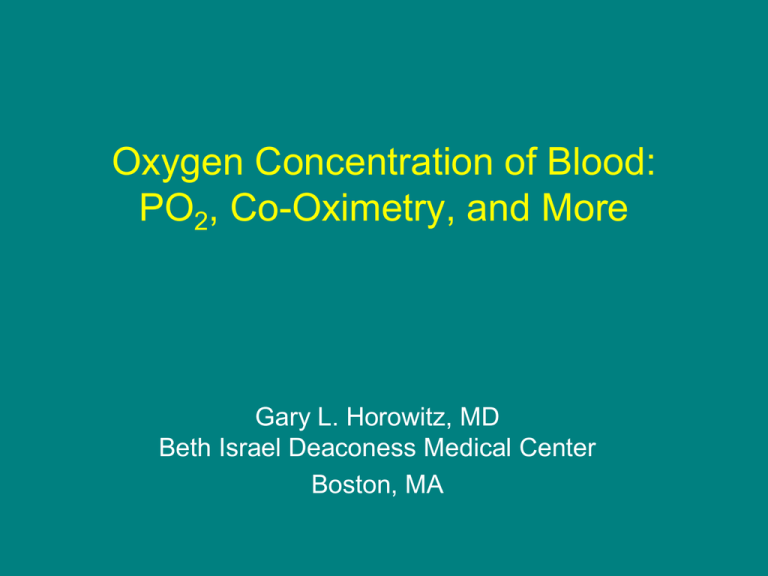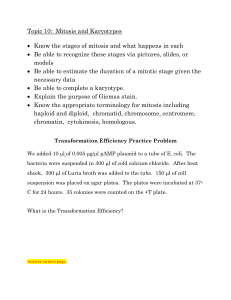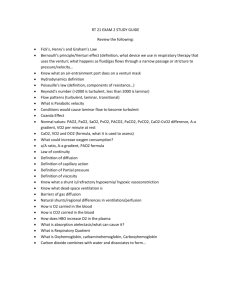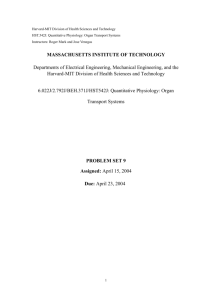Oxygen Concentration Of Blood
advertisement

Oxygen Concentration of Blood: PO2, Co-Oximetry, and More Gary L. Horowitz, MD Beth Israel Deaconess Medical Center Boston, MA Objectives • Define “O2 Content”, listing its 3 major variables • Define the limitations of pulse oximetry • Explain why a normal arterial PO2 at sea level on room air is ~100 mmHg (13.3 kPa) • Describe the major features of methemogobin and carboxyhemglobin O2 Concentration of Blood • not simply PaO2 – Arterial O2 Partial Pressure ~100 mm Hg (~13.3 kPa) • not simply Hct (~40%) – or, more precisely, Hgb (14 g/dL, 140 g/L) • not simply “O2 saturation” – i.e., ~89% O2 Concentration of Blood • rather, a combination of all three parameters • a value labs do not report • a value few medical people even know! O2 Content mm Hg g/dL = 0.003 * PaO2 + 1.4 * [Hgb] * [%O2Sat] = 0.0225 * PaO2 + 1.4 * [Hgb] * [%O2Sat] kPa • normal value: about 20 mL/dL g/dL Why Is the “Normal” PaO2 90-100 mmHg? • PAO2 = (FiO2 x [Patm - PH2O]) - (PaCO2 / R) – – – – – – – – PAO2 is alveolar O2 pressure FiO2 is fraction of inspired oxygen (room air ~0.20) Patm is atmospheric pressure (~760 mmHg at sea level) PH2O is vapor pressure of water (47 mmHg at 37 oC) PaCO2 is partial pressure of CO2 R is the respiratory quotient (typically ~0.8) 0.21 x (760-47) - (40/0.8) ~100 mm Hg • Alveolar–arterial (A-a) O2 gradient is normally ~ 10, so PaO2 (arterial PO2) should be ~90 mmHg NB: To convert mm Hg to kPa, multiply by 0.133 Insights from PAO2 Equation (1) • PaO2 ~ PAO2 = (0.21x[Patm-47]) - (PaCO2 / 0.8) – At lower Patm, the PaO2 will be lower • that’s why airplane cabins are pressurized – At higher Patm, the PaO2 will be higher • we’ll exploit this later – Also: • “normal” PaO2 in Boston is higher than in Denver • your PaO2 is lower during a storm than on a sunny day NB: To convert mm Hg to kPa, multiply by 0.133 Insights from PAO2 Equation (2) • PaO2 ~ PAO2 = (0.21x[Patm-47]) - (PaCO2 / 0.8) – On room air (FiO2 = 0.21), at a given Patm, • As PaCO2 decreases, PaO2 increases – Patients who hyperventilate should have higher PO2s – Don’t be surprised if a patient with a PCO2 of 20 has a PO2 of 120 – it’s expected! • As PaCO2 increases, PaO2 decreases – Patients with lung disease will have not only increased PaCO2 but lower PaO2 – Don’t be surprised if a patient with a PaCO2 of 60 has a PaO2 of 150-80-10 = 70 NB: To convert mm Hg to kPa, multiply by 0.133 Why is the “Normal” “O2 Saturation” ~95%? • sigmoid curve • hemoglobin can bind ~ 1.4 mL O2/g when fully saturated • at PO2 = 100 mmHg, 100% saturated • so, at a normal Hgb of ~14 g/dL), it holds 1.4x14 = 19.6 mL/dL www.uptodate.com NB: To convert mm Hg to kPa, multiply by 0.133 A Quick Review • Under typical conditions, for the reasons given, PaO2 is ~100 mm Hg (~13.3 kPa) • Based on the oxyhemoglobin dissociation curve, that PaO2 corresponds to 100% “O2 saturation”, and each gram of Hgb can hold 1.4 mL of O2 • So, returning to our O2 content equation, we’ve explained the right-hand term = 0.003 * PaO2 + 1.4 * [Hgb] * [%O2Sat] So, What’s the Other Term? • Actually, it’s quite simple: dissolved O2 • And the equation for it is equally simple: – 0.003 x PO2 (mm Hg) [0.0225 X PO2 (kPa)] i.e., directly proportional to the partial pressure of O2 – at typical PO2’s, it is negligible: 0.003 x 100 mm Hg = 0.3 mL/dL 0.0225 x 13.3 kPa = 0.3 mL/dL (vs Hgb-bound O2 of 19.6 ml/dL, which we just calculated) O2 Concentration of Blood • rather, a combination of all three parameters • a value labs do not report • a value few medical people even know! O2 Content = 0.003 * PaO2 + 1.4 * [Hgb] * [%O2Sat] 0.3 dissolved 19.6 Hgb-bound ~ 20 mL O2/dL Different Scenarios Illustrating Oxygen Content Concepts HgbBound O2 O2 Content comments PaO2 %O2Sat Hgb Hct Dissolved Oxygen Normal 100 100 14 42 0.3 19.6 19.9 Low Hct 100 100 7 21 0.3 9.8 10.1 Low PaO2 (lung disease) 25 50 14 42 0.1 9.8 9.9 50% Methemoglobin 100 50 14 42 0.3 9.8 10.1 Very Low Hct No Transfusion 100 100 2 6 0.3 2.8 3.1 Hyperbaric Chamber 2200 100 2 6 6.6 2.8 9.4 Causes of Low Oxygen Concentration • anemia (low hemoglobin/hematocrit) – what most physicians focus on – probably the most frequent cause • low PaO2 low “O2 saturation” – e.g., lung disease • low “O2 saturation” despite normal PO2 – i.e., carboxyhemoglobin or methemoglobin Hemoglobin Species • Oxyhemoglobin – oxygenated • Reduced (Non-Oxygenated) Hemoglobin – capable of becoming oxygenated • Carboxyhemoglobin (carbon monoxide) – cannot be oxygenated • Methemoglobin (oxidized Fe moiety) – cannot be oxygenated • How do we measure/distinguish them? Spectrophotometry Tietz NW (Ed). Fundamentals of Clinical Chemistry. 2nd Edition. 1976. With One Measurand, Life is Simple • A=ε*b*C (or A=abc) • Absorbance = (Molar Absorbtivity)*(Pathlength)*(Concentration) • Two ways to calculate C from measured A – Know ε and b • co-oximeter – Run standard(s) to calculate • most assays ε*b Absorbances Are Additive • If two species (M and N) are present, and each has absorbances at two wavelengths, you can solve two simultaneous equations to b = known determine their concentrations pathlength • Aλ1 = (εMλ1)(b)([M]) + (εNλ1)(b)([N]) • Aλ2 = (εMλ2)(b)([M]) + (εNλ2)(b)([N]) • 0.845 = 0.0265 [M] + 0.0543 [N] • 0.675 = 0.0453 [M] + 0.0277 [N] [M] = 7.9, [N] = 11.7 known molar absorbtivities Absorbances Are Additive: General Principle • To measure n species, you need measurements at n wavelengths • Pulse oximeters: 2 wavelengths 2 species Adapted from: Haymond S. Oxygen saturation. Clinical Laboratory News. February, 2006. • Co-Oximeters: >4 wavelengths >4 species Pulse Oximeters & Abnormal Hemoglobins • “simplifying” assumption: only oxyhemoglobin and reduced hemoglobin are present • works most of the time, but not all of the time Barker SJ et al. Anesthesiology 1989;70:112-117. • tends to overestimate oxyhemoglobin, just what you don’t want Oxygen Delivered to Tissues oxygen delivered = arterial O2 content –venous O2 content O2 Saturation (%) 70% 55% 8.0 40% 0 20 40 60 PO2 (mm Hg) typical venous PO2 10.9 P50 = PO2 where O2 saturation is 50% 80 100 typical arterial PO2 Blue: 18 (left-shift) Black : 25 (normal) Red: 37 (right shift) Oxyhemoglobin Terminology • Currently, there are 3 terms used for “oxygen saturation” (CLSI C-46, 2009) – hemoglobin oxygen saturation (SO2) – fractional oxyhemoglobin (FO2Hb) – estimated oxygen saturation (O2Sat) • in normal individuals, these values match closely • but, in patients, they can be significantly different • In general, physicians and other health care professionals – use the term O2sat (#3) to mean hemoglobin oxygen saturation (#1) – have never heard of the term fractional oxyhemoglobin (#2), though that is what co-oximeters “should” report Oxyhemoglobin Terminology • SO2 is calculated as: – oxyhemoglobin / (oxyhemoglobin + reduced hemoglobin) – represents the percentage of hemoglobin capable of being oxygenated that is oxygenated – in other words, the denominator explicitly omits from consideration methemoglobin or carboxyhemoglobin Oxyhemoglobin Terminology • FO2Hb – oxyhemoglobin / (total hemoglobin) – represents the percentage of all hemoglobin present that is oxygenated – when methemoglobin or carboxyhemoglobin is present, they are included in the denominator Oxyhemoglobin Terminology • O2Sat – An estimate of what the oxyhemoglobin should be using the measured PO2 and the oxyhemoglobin dissociation curve, assuming that 1) that the patient’s blood sample is absolutely typical (pH, temperature, 2,3-DPG concentration, etc.), and 2) that no methemoglobin or carboxyhemoglobin is present – This calculation, common on ABG analyzers, should not be reported Example: Fireman Brought Into Emergency Room With Smoke Inhalation • The facts: – PO2 = 120 (hyperventilation) – hemoglobin fractions: oxy=80%, reduced=0%, carboxy=20%, met=0% • The CLSI values: – SO2 = 100% – FO2Hb = 80% – O2sat = 100% [80/(80+0)] [80/(80+0+20+0)] [at PO2= 100 mmHg, normal hemoglobin is 100% saturated] • My practice (though it is technically incorrect), is to report the value as 80% and call it O2Sat • At a minimum, make sure your clinicians know how your lab is handling these values Methemoglobin • we all make methemoglobin continuously • normal values are roughly 1% • represents oxidation of heme Fe atom from ferrous (+2) to the ferric (+3) state • normally, our bodies reduce methomoglobin back to hemoglobin • with increased oxidative stress (e.g., drugs) or with defective enzymes, methemoglobin can increase to pathologic levels • patients present with shortness of breath (low O2 content) and cyanosis (blue color) • arterial blood looks brown, despite high PO2 Carboxyhemoglobin • represents hemoglobin complexed with carbon monoxide (CO) • causes: • fires (smoke inhalation) • using gas or charcoal grills indoors • smoking • air pollution (living in urban areas) • every home should have a CO (as well as a smoke) detector! • patients present with shortness of breath (low O2 content) • in contrast to methemoglobin, • blood is “cherry red” • FO2Hb (co-oximetry) is low despite high PO2 • pulse oximetry overestimates oxyhemoglobin Self-Assessment Question 1 Which is the best indicator of oxygen concentration in blood? A) B) C) D) PO2 Hematocrit O2 content O2 saturation Self-Assessment Question 1 Which is the best indicator of oxygen concentration in blood? A) B) C) D) PO2 Hematocrit O2 content O2 saturation Self-Assessment Question 2 Which of the following is true? A) A normal alveolar PO2 is higher in Denver than in Boston because the air is cleaner B) A normal fractional oxyhemoglobin is higher in Denver than Boston because it has less air pollution C) Typical pulse oximeters provide reliable measurements of “oxygen saturation” for use in patients with smoke inhalation D) One must use arterial blood to get an accurate assessment of methemoglobin concentrations Self-Assessment Question 3 What method principle is involved in measuring oxyhemoglobin percentages? A) B) C) D) Gas chromatography Ion selective electrodes Beer’s Law O2 electrode, followed by interpolation from oxyhemoglobin dissociation curve Answers 1 (C) O2 content 2 (B) A normal fractional oxyhemoglobin is higher in Denver than Boston because it has less air pollution 3 (C) Beer’s Law




